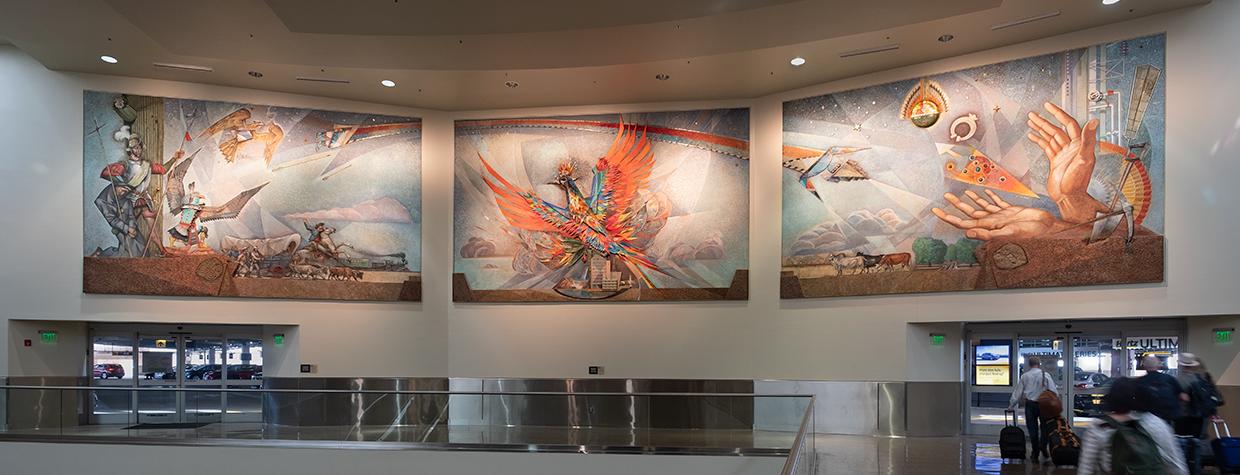“From the texts of the early writers to that of contemporaries, from the temples of the Mediterranean Sea to the fanciful designs of coats of arms, the phoenix bird, described in different ways, resurrected at different times but nevertheless constantly a self-burning bird, has given a message to men. … In his belief that there is another world, man certainly is himself a phoenix, triumphant, refusing to be cast down by the thought of an end.”
Paul Coze was best known as an artist, but he had a way with words, too. He wrote those in the March 1963 issue of Arizona Highways, as part of a lengthy exploration of the role the phoenix had played in human history. The inside front cover of that issue showed one manifestation of Coze’s fascination: his 75-foot-wide, 16-foot-tall mural The Phoenix, which had been installed and dedicated at Phoenix’s Sky Harbor Airport the previous year. And there it stayed, greeting travelers at Terminal 2, for more than half a century.
But as Sky Harbor grew into an international hub, Terminal 2 grew obsolete. It closed in 2020 and was slated for demolition, leaving the fate of Coze’s mural unclear. Now, thanks to an intensive relocation effort, The Phoenix has risen again. “There was so much input from the community that this needed to be saved,” says Gary Martelli, manager and curator of the Phoenix Airport Museum. “It’s a very iconic and beloved mural.”
Born in Beirut in 1903 to a French father and a Russian mother, Coze (rhymes with “rose”) dabbled in writing, artwork and plays, but he had an enduring fascination with the American West and its Indigenous peoples. He led expeditions to North America while studying in Paris, and the connections he developed led to his becoming an adopted member of seven tribes. He later immigrated to the U.S. and lived in Los Angeles, working as a technical consultant for films, before moving to Phoenix, opening a school and studio, and turning his focus to art.
Coze’s public artwork in Phoenix included murals at the Arizona Veterans Memorial Coliseum and another mural (since removed) at the City Council chambers, along with a phoenix sculpture at the Town & Country shopping center on Camelback Road. But The Phoenix may be his most famous work, and it is believed to be the first piece of public art commissioned by the city and chosen through public input, with citizens voting on which artist would create the signature airport mural.
“When he came up with the design, he had a sketch and was just going to do a traditionally painted mural with oil paints, which was typical of the time,” Martelli says. “Then he had the idea to change that, and even after he won the commission, he had to present new designs, because he wanted to use alternative materials, non-traditional methods and more of a mosaic approach.”
And so, The Phoenix’s three panels incorporate 52 different materials, including silver, copper, turquoise, petrified wood and broken glass. The titular bird’s beak is made of shells, obsidian and other substances, and on its body, in relief, are 365 feathers — one for each day of the year. The bird dominates the center panel, which symbolizes Phoenix’s present, and it’s flanked by panels depicting the city’s past (the Hohokam people, European settlers and the Mormon Battalion) and future (a focus on electronics and a move away from agriculture).
The mural long outlived Coze, who died in 1974. But various Terminal 2 remodels over the years made it harder to view the piece, and dust and nicotine stains took a toll. By 2006, it was clear Terminal 2’s days were numbered, so a conservator examined the mural to assess its condition and what it would take to relocate it. Later investigations found the piece was mounted only to the plaster interior wall, which would make it easier to remove.
The airport partnered with International Chimney Corp., a company that specializes in moving large structures, for the relocation, which involved removing the exterior wall behind the mural a section at a time, attaching ironwork to the piece and drilling holes in the roof to allow the mural to be lowered to the ground. The panels then were reinforced, put on flatbed trailers and trucked to a storage facility before going back on display at the Rental Car Center, southwest of the two remaining terminals, in October 2021.
Today, the mural is again a major component of the Phoenix Airport Museum, which promotes Arizona’s art and culture with curated exhibitions and artworks in more than 50 display areas at Sky Harbor. Ninety percent of what’s on display can be viewed without passing through a security checkpoint, and visiting the Coze mural will get even easier later this year, when the PHX Sky Train begins running to the Rental Car Center.
Accompanying The Phoenix are exhibitions about Terminal 2 and the making of the mural, along with a viewing scope that allows visitors to see details that aren’t visible without magnification. The piece was thoroughly cleaned after the move, and Martelli says it now looks better than ever, in part because of its new setting. “There’s better lighting, and it’s very colorful and vibrant, so all that materiality kind of sparkles,” he says. “It’s already over 50 years old, which is pretty tremendous in the life of public art.”
PHOENIX
Phoenix Airport Museum
602-273-2744
skyharbor.com/museum

